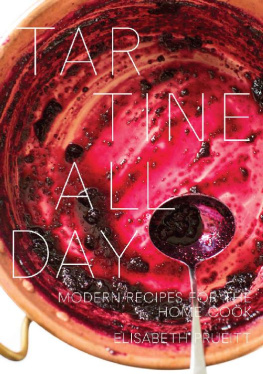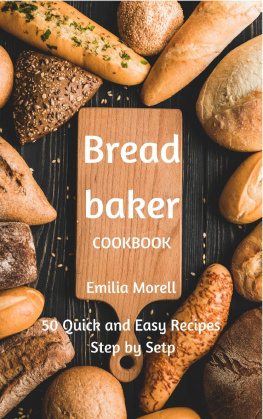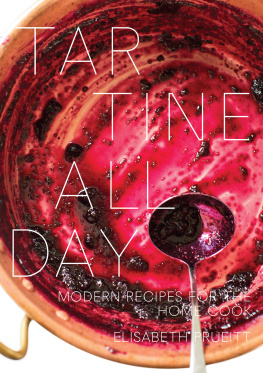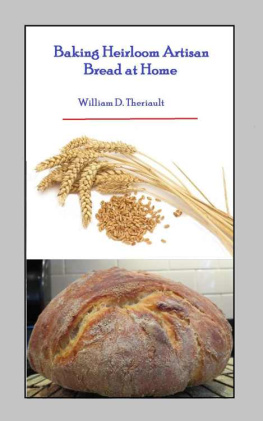


For Archer and Elisabeth

Text copyright 2010 by Chad Robertson.
Photographs copyright 2010 by Eric Wolfinger and Chad Robertson.
All rights reserved. No part of this book may be reproduced in any form without written
permission from the publisher.
ISBN 978-1-4521-0028-9
The Library of Congress has previously cataloged this title under ISBN 978-0-8118-7041-2
Designed by VANESSA DINA.
Food and prop styling by ERIC WOLFINGER and CHAD ROBERTSON.
Typesetting by JANIS REED.
Photograph on by Catherine Karnow.
Front cover image and photographs on by Chad Robertson.
Photographs on by Suzanne Yacovetti.
Illustrations by David Wilson.
: Les Canotiers de la Meurthe, mile Friant, 1888. Courtesy of Le Muse de lcole de Nancy.
Chronicle Books LLC
680 Second Street
San Francisco, California 94107
WWW.CHRONICLEBOOKS.COM
Bread in Time
My strongest inspiration came not from real bread but from imagesimages of a time and place when bread was the foundation of a meal and at the center of daily life. There is a painting of boaters gathered at a riverside table. At the head, a large crusty loaf held close to the heart is cut into wedges to commence the meal. This scene was painted a little more than a century ago in France, when a workers portion of bread was two pounds per day, and bread was on every table at mealtime. This was elemental bread that sustained generations. To find this bread, I would have to learn make it. Thus began my search for a certain loaf with an old soul.
I opened my first bakery nearly fifteen years ago after three years of formal apprenticeship and with the vision of my ideal loaf taking shape. Each loaf would tell the hands of the baker who made it, and each would also have its own expressionlike a clay vessel pulled from the kiln after firing. The loaf would be baked dark, and the substantial, blistered crust would hold some give while containing a voluptuous, wildly open crumb with the sweet character of natural fermentation and a subtle balanced acidity. The bread would be a joy to eat fresh and would keep well for a week.
Although I had apprenticed with some of the finest artisan bakers in the United States and France, none had taught me how to make the loaf I was envisioning. Instead, they gave me the tools to get there.
From my first mentor, I learned to approach bread making as both a craft and a philosophy of ingredients and how they interact. With that understanding came the promise that I could find my way to any bread I imagined. Dough is dough, he liked to say, implying that all breads are closely relatedeven the ones that seemed quite different.
After years of learning, I realized I would never get there working under the tutelage of someone else. I was twenty-three when Elisabeth, now my wife, and I built our first small bakeshop with the help of friends north of San Francisco, along the coast of Tomales Bay. Bakeshop was an apt name for the room where I would spend the next six years working. We cut a hole in the wall and built a wood-fired oven outside facing into the shop. The shop was one step from the home where we lived. Technically, I was a home baker with a big oven. I would have to make hundreds of loaves a day for years in a sort of solitary baking trance to achieve what I had in my minds eye.
I started with the wood-fired oven and no mixer. The rigor of mixing three hundred pounds of dough by hand required a softer dough, so I added more water.


During my first apprenticeship, I had worked with wet doughs, so this was familiar territory. The oven was fired all day as the dough was mixed, shaped, and set to rise on cloths. The loaves were ready to bake a few hours after shaping, and I baked through the night. But after months with little sleep, I changed my course. Opening the windows in the evening cooled the dough down and slowed the final rising significantly. The bake could wait until the next morning.
I held close to my ideal, but after such a long rise, the resulting bread was sometimes more sour than I wanted. To counter this, I began using my wild yeast starter at a younger, more mild stage until I achieved the complex flavors I was after with the right balance of acidity. Now, I could get a decent nights rest, freed from the life of bats. The only problem with this new schedule was that I would have to bake later in the day and sell bread in the afternoon. So thats what I did: gaining the pleasures of warm bread for dinner and toast for breakfast. After a decade of working alone, I took on my first apprentices. I had spent almost half my life obsessing over bread; it was now something I did, not something I talked about. Making bread had become a mostly silent meditation for me, and I liked it that way. It would take a fortuitous trade agreement to draw me out.
In 2005, Eric Wolfinger came to work at Tartine with no baking experience. He was on track to becoming a chef before he decided to try his hand at baking. Eric grew up surfing in Southern California and noticed that I had an ideal surfing schedule: starting my day around noon and finishing in the early evening. He suggested a trade. He offered to teach me to surf, and I would teach him to make bread. Erics persistence wore me down, and I agreed to try surfing.
By the time my sore ribs had healed from my first surfing session, I had a new obsession, and he was the one to talk to. He followed my every surfing question with another question about bread. During those long drives up and down the coast, we often had two conversations going on at once. Months and years passed as we learned together, surfing in the morning and baking in the afternoon.
Lucky for me, Eric stuck around long enough to learn to make great bread, gaining the keen understanding of my approach that would make our collaboration on this book possible.
Over the course of time, I articulated what had been only in my head and redefined for myself the craft of bread making. The idea was to distill the content of our daily discussions into techniques that would work well for the home bakerto make a bakers guidebook.
Traditional, intuitive bread making does not lend itself naturally to a written recipe. Before the study of microbiology, bakers understood the subtleties of the process. The nature of fermentation was second nature to their own. That is, they understood fermentation in relation to the rhythms of their own lives. It is necessarily the same with modern artisan bakers. All points lead back to the starter and the leaven as origin of the process, and the way that they are used to manage fermentation determines the outcome. Then, as now, the most important aspect of making bread was managing the stages of fermentation by knowing what to look for. The visual element would be an integral part of this book project. There was no question in my mind that Eric had to document our work. He was uniquely qualified by his experience, his daily baking shift, and his passion for photography.
Next page











